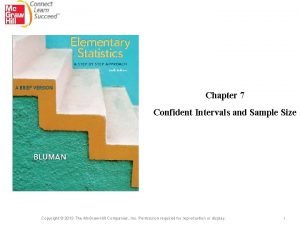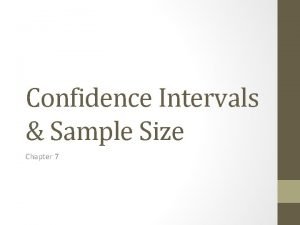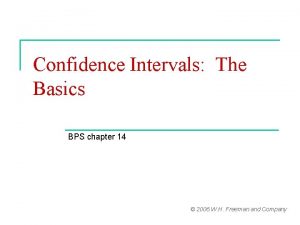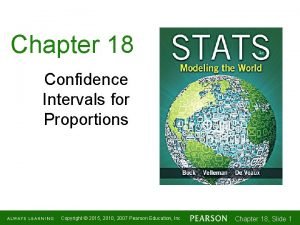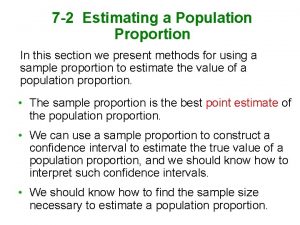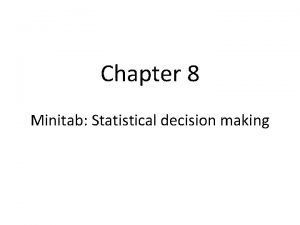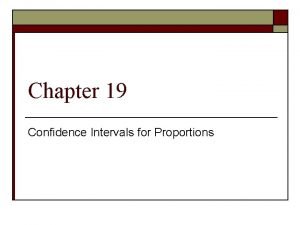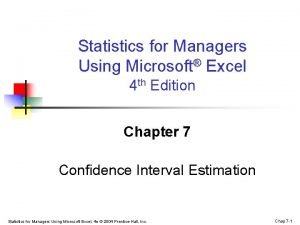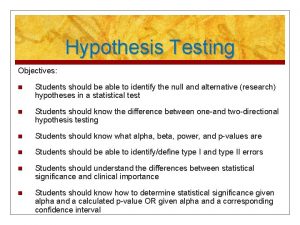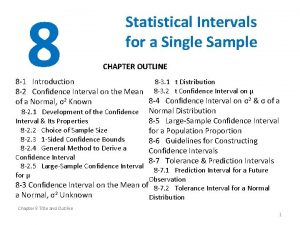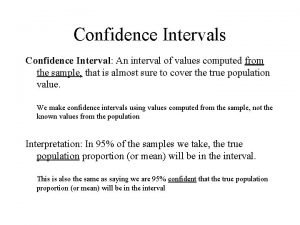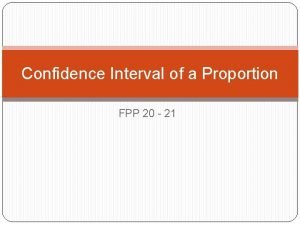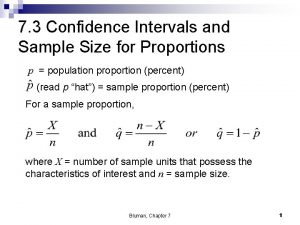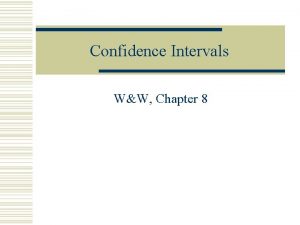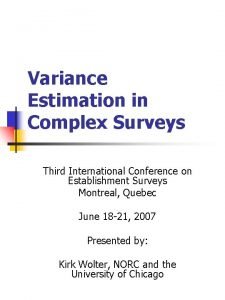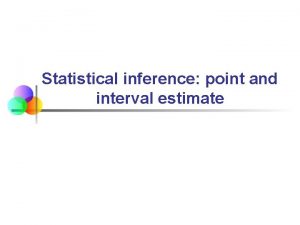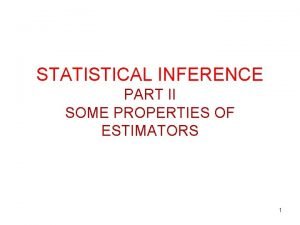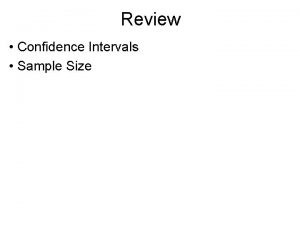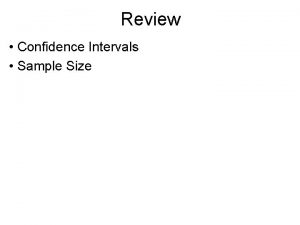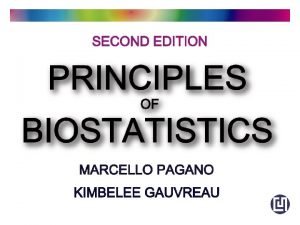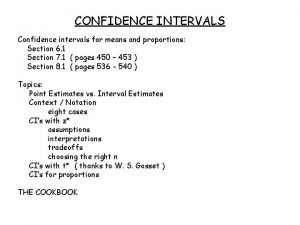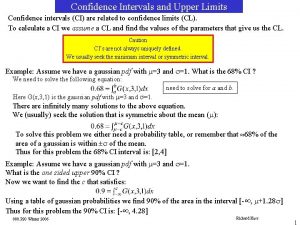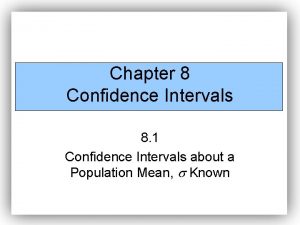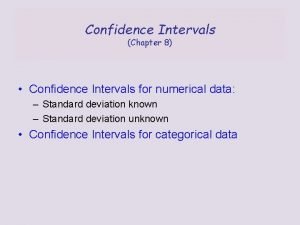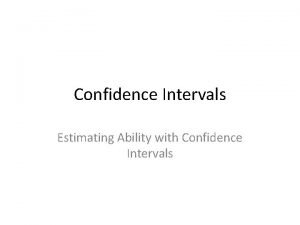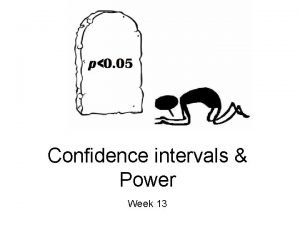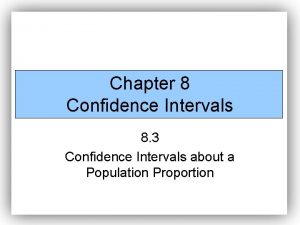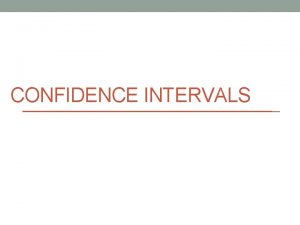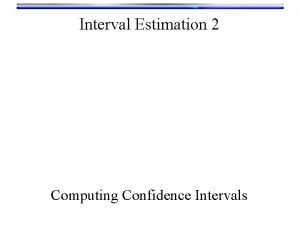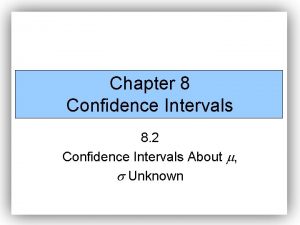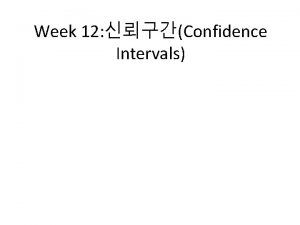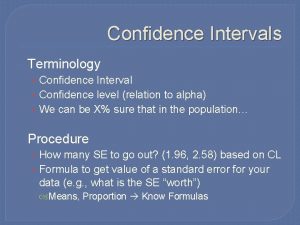Review Confidence Intervals Sample Size Estimator and Point























- Slides: 23

Review • Confidence Intervals • Sample Size

Estimator and Point Estimate An estimator is a “sample statistic” (such as the sample mean, or sample standard deviation) used to approximate a population parameter. A Point Estimate is a single value or point used to approximate a population parameter. A point estimator may be biased or unbiased.

Central Limit Theorem Take ANY random variable X and compute m and s for this variable. If samples of size n are randomly selected from the population, then: 1) For large n, the distribution of the sample means, will be approximately a normal distribution, 2) The mean of the sample means will be the population mean m and 3) The standard deviation of the sample means will be

Confidence Intervals The Confidence Interval is expressed as: E is called the margin of error. For samples of size > 30,

Sample Size The sample size needed to estimate m so as to be (1 -a)*100 % confident that the sample mean does not differ from m more than E is: …round up

Practice Problems • #7. 11 page 329 • #7. 19 page 331 • #7. 21 page 331

Small Samples What happens if and n is small (n < 30)? Our formulas from the last section no longer apply.

Small Samples What happens if and n is small (n < 30)? Our formulas from the last section no longer apply. There are two main issues that arise for small samples: 1) s no longer can be approximated by s 2) The CLT no longer holds. That is the distribution of the sampling means is not necessarily normal.

t- distribution If we have a small sample (n < 30) and wish to construct a confidence interval for the mean we can use a t-statistic, provided the sample is drawn from a normally distributed population.

t-distributions s is unknown so we use s (the sample standard deviation) as a point estimate of s. We convert the nonstandard t-distributed problem to a standard t-distributed problem through the use of the standard t-score

t-distributions • Mean 0 • Symmetric and bell-shaped • Shape depends upon the degrees of freedom, which is one less than the sample size. df = n-1 • Lower in center, higher tails than normal. • See Table inside front cover in text

Example In n=15 and after some calculation a/2=0. 025, t 0. 025 = 2. 145

Confidence Interval for the mean when s is unknown and n is small The (1 - a)*100% confidence interval for the population mean m is The margin of error E, is in this case N. B. The sample is assumed to be drawn from a normal population.

Confidence Intervals for a small sample population mean The Confidence Interval is expressed as: The degrees of freedom is n-1.

Example The following are the heat producing capabilities of coal from a particular mine (in millions of calories per ton) 8, 500 8, 330 8, 480 7, 960 8, 030 Construct a 99% confidence interval for the true mean heat capacity. Solution: sample mean is 8260. 0 sample Std. Dev. is 251. 9 degrees of freedom = 4 a = 0. 01 7741. 4 m 8778. 6

Confidence intervals for a population proportion The objective of many surveys is to determine the proportion, p, of the population that possess a particular attribute. If the size of the population is N, and X people have this attribute, then as we already know, is the population proportion.

Confidence intervals for a population proportion If the size of the population is N, and X people have this attribute, then as we already know, is the population proportion. The idea here is to take a sample of size n, and count how many items in the sample have this attribute, call it x. Calculate the sample proportion, . We would like to use the sample proportion as an estimate for the population proportion.

Therefore at the (1 -a)*100 % level of confidence, the Error estimate of the population proportion is At the (1 -a)*100 % level of confidence, the confidence interval for the population proportion is :

Determining Sample Size In calculating the confidence interval for the population proportion we used Perhaps we might be interested in knowing how large a sample we should use if we are willing to accept a margin of error E with a degree of confidence of 1 -a.

Determining Sample Size If we already have an idea of the proportion (either through a pilot study, or previous results) one can use If we have no idea of what the proportion is then we use

In Class Exercises • #7. 31, 7. 36, 7. 41 Pages 341, 342 • #7. 50, 7. 57 on page 349, 350 • #7. 75, 7. 78 Pages 356, 357

Shortcut for finding za/2 • Recall that as n the Student’s Tdistribution approaches the normal distribution. • Look at T-table inside front cover, the last row represents the values of tn-1, a/2, as n becomes large which is essentially za/2. • Therefore, for some common values of a we are able to find za/2 quite quickly. • z 0. 025 =1. 960, z 0. 10 =1. 282

Homework • Review Chapter 7. 3 -7. 5 • Read Chapters 8. 1 -8. 3 • Quiz on Tuesday: Chapter 5 23
 Confidence interval variance formula
Confidence interval variance formula How to find the t score for a confidence interval
How to find the t score for a confidence interval How to find sample size of confidence interval
How to find sample size of confidence interval Deveiation
Deveiation How to interpret confidence intervals example
How to interpret confidence intervals example Reporting confidence intervals
Reporting confidence intervals Chapter 19 confidence intervals for proportions
Chapter 19 confidence intervals for proportions Confidence interval for proportion excel
Confidence interval for proportion excel Chapter 18 confidence intervals for proportions
Chapter 18 confidence intervals for proportions Estimating a population proportion
Estimating a population proportion Confidence interval on ti 84
Confidence interval on ti 84 Minitab confidence interval
Minitab confidence interval Chapter 19 confidence intervals for proportions
Chapter 19 confidence intervals for proportions How to add 95 confidence intervals in excel
How to add 95 confidence intervals in excel Confidence interval vs confidence level
Confidence interval vs confidence level Statistical intervals based on a single sample
Statistical intervals based on a single sample Confidence interval for sample proportion
Confidence interval for sample proportion Confidence interval for sample proportion
Confidence interval for sample proportion Sample proportion confidence interval
Sample proportion confidence interval Confidence interval review
Confidence interval review Estimator of variance
Estimator of variance Tsp ballpark estimator
Tsp ballpark estimator What is a point estimate in statistics
What is a point estimate in statistics Properties of good estimator
Properties of good estimator
